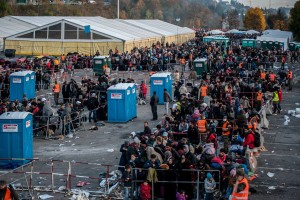
What specific challenges has the position of your country on the refugee corridor between the Mediterranean and Western Europe brought in the past months, in relation to numbers of refugees transiting (issues such as asylum laws, transport, border control)?
For those people who are familiar with the context and history of migration and asylum in Hungary, the situation from the summer did not come as a surprise. Asylum laws have been steadily tightened ever since the numbers started to increasing in 2013, but it must be said that the 2015 law represents a significant leap towards criminalization as crossing the border fence was declared a criminal offense punishable by serving time in Hungarian prisons. The biggest challenge of the summer was definitely the confusion and arbitrary application of the law, most notably the Dublin regulation and its circumstantial application. After Germany suspended Dublin for Syrians, it was unclear whether they should still be fingerprinted in Hungary. It also lead to a situation where there was an system of 1st class and 2nd class refugees, creating many tensions between the Afghan, Syrian, Iraqi and Pakistani communities. Transportation, housing and the concrete management of the humanitarian situation was only a challenge because of political will. Only last winter Orbán declared that Hungary would be ready to take in 170,000 Ukrainian refugees should the need arise. For Middle Easterners, the political will was not there. At the moment the true challenge is how to protest against the fence on the border, as touching the fence is, as said, a criminal offense. The other, related, challenge is how to transform the humanitarian impetus into political demands to open the Hungarian border again.
How have the state and the police responded to the refugee crisis? How has your country been involved in the FRONTEX and EU border regime prior to the crisis and what has changed since?
After the asylum system of Greece was declared dysfunctional, Hungary became the main entry route to the EU and most notably to the Schengen zone some years ago. The international community was slow to react to this, and until summer 2015, the popular migration map simply ended in Greece, as if migrants would actually stay there. The numbers of migrants crossing through, and applying for asylum in Hungary has increased exponentially over the last few years. Hungary has received help, and equipment, from Frontex, and the patrolling on the border has been a peculiar mix of Frontex-equipment and trained border guards, and semi-official civic guards. I recommend a documentary from a few years ago, Superior Orders, for anyone interested in seing how it worked. Now, of course there is a fence, which puts Hungary in a particularly strange situation in Europe: on one hand, Hungary-bashing is (for very good reasons) more popular than ever in the Western press (for reasons exceeding the migration crisis), but on the other hand, nobody in the whole of Europe has voiced a specific critique of the fence. Indeed, it suits Germany and other powerful EU member states quite well, and I am pretty sure that behind the scenes they are happy about Orban’s migration policies.
Where is the support for the refugees coming from in your country? Which specific organizations (governmental or NGOs), networks of activists and volunteers are involved? Do you cooperate with regional actors and on what levels for which purposes?
Traditionally, the migration-field in civil society had only a few players: the Hungarian Helsinki Committee dealt with legal issues, UNHCR with lobbying and politics behind the scenes, the Menedek Foundation with EU-supported projects on integration, research and excellent trainings for professionals, to name a few. Migszol Csoport was born in 2012 from the feeling that there needs to be an approachable, informal grassroots initiative as well. This summer saw the emergence of a number of volunteer groups, such as Migration Aid, that were mostly dealing with humanitarian work (unlike Migszol – although our members were as individuals aking part in the humanitarian work, the standpoint of the group is that the humanitarian crisis neds a political solution). Now that the numbers of new migrants and asylum seekers is becoming marginal, and state-induced racism even harsher, it will be interesting to see how the humanitarian groups, at least of which by now have registered as an NGO, will continue their work. In general, all the actors in the field cooperate very well together, and if there is anything in which we need each other’s help, we don’t hesitate to pick up the phone and share news or plan common actions.
We get a lot of requests for regional and Europe-wide cooperation as well. Given that we are not an NGO, and don’t wish to be, we usually prioritize No Border-networks around Europe, but sometimes we also cooperate with NGOs. Of course, then there is the whole matter of giving information to large human rights organizations such as Amnesty International and Human Rights Watch – this is also something that we have done.
What is the response of the local population? What are the main arguments against or in support of the refugees which you have heard?
Thanks to a number of xenophobic campaigns that the Hungarian government invested in, the population is very polarized. On one hand, you have thousands and thousands people who have become active in terms of volunteering. The main arguments have been that we need to support human beings regardless of their origin. Interestingly, however, we have not seen much public opinion that would state that we need to make Hungary into a country where it would be possible and desirable to settle down. The arguments against echo the statements of the Hungarian conservative right: we hear of the different cultural/religious traditions of Muslims, of danger to Hungarian culture, of immigrants taking away the jobs of Hungarians, and the like. Gender-issues come up a lot, and racists love to talk about the ‘different courting habits’ of Muslims, where Muslim men are portrayed as dangerous to Hungarian women. I find that extremely ironic given that Hungary, even without immigrants, is a country that is far from having achieved gender equality – just look at the composition of the government, for instance.
At Migszol, we think that the campaign against migrants and refugees is just another facet of the war that the Fidesz government is waging on the poor and the Roma, and therefore also the cooperation between the different struggles is very important. Especially the Hungarian Roma community has stood in solidarity with migrants. We are now trying to send the message that while there are no migrants coming to Hungary, not only do we ned o seek a political solution together to open th border, but we also ned to support the efforts of other grassroots organizations that are fighting the racism and creeping fascism of the Hungarian government.
5) How do you see the situation evolving in the next months?
Sadly, not much. The fence is erected, the Croatian border has also been shut for migrants, and the legal fence prevents any migrants from applying asylum in Hungary – they are nearly automatically deported to Serbia, should they do so. The question remains that how the Croatia-Slovenia situation will develop – if it becomes very difficult, we will see whether or not the route will change to Serbia-Romania-Hungary-Austria. Also, there are many migrants and refugees living in Hungary who face racism on a daily basis, and we are trying to country the narrative of the government that there would not be any migrants “left” in the country. We hope that in the next months the people who have been involved in the summer – which is a huge number of people – will actively start demanding decision makers to change the asylum law and to get rid of the shameful fence. This is the main objective of our work as well, through means of awareness raising, events and campaigns. It is also becoming clearer and clearer that more regional cooperation is needed to fight the policies of the EU.


